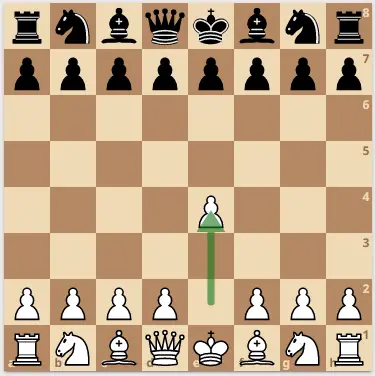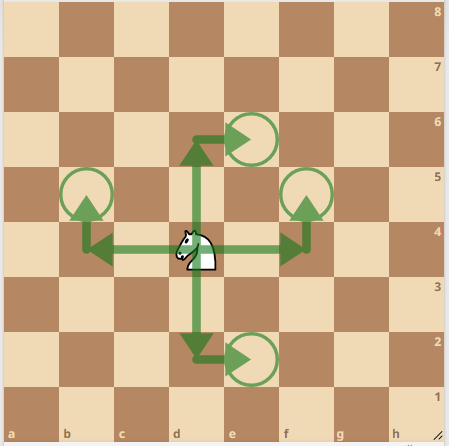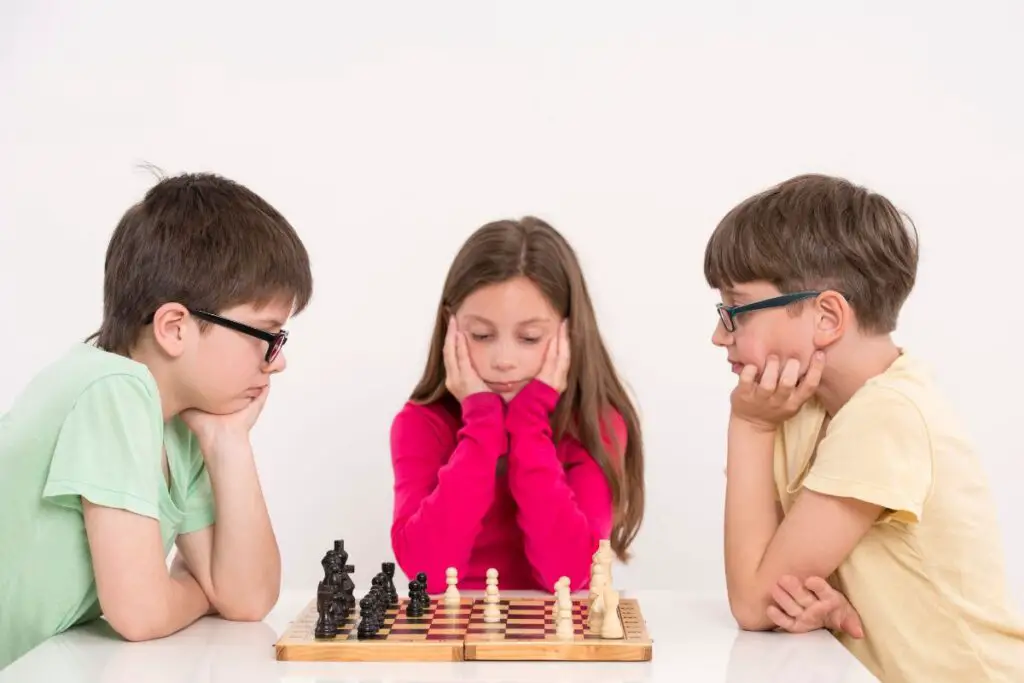Chess is one of the most fun and useful games in the world for children. Not only is it an enjoyable pastime, but it can develop your kid’s critical and strategic thinking skills.
To teach your kids to play the game, you’ll have to describe the role of each chess piece. Then, you can move on to explaining the board and the rules. Finally, tell them that the white side always starts the game and you’re ready for your first match.
In this article, we’ll walk you through everything you need to know about playing chess. We’ll also discuss the standard layout of the chessboard to help you get started.
Playing Chess for Children
There are a few different aspects to every chess game. In this section, we’ll go over the most important factors and how they come into play.
Objective Of The Game
The objective of a chess game is to checkmate your opponent’s king.
Checkmate occurs when a player’s king is under attack and there is no legal move that the player can make to get out of check. If a player’s king is in checkmate, the game is over and that player loses.
To achieve checkmate, a player must use their pieces to attack and control the board, while also defending their own king. The game can end in a few different ways:
- Checkmate: as described above, when a player’s king is under attack and there is no way to get out of check.
- Stalemate: when a player is not in check but has no legal move available. The game is a draw if stalemate occurs.
- Resignation: when a player voluntarily resigns the game, conceding defeat.
- Draw: when neither player is able to achieve a win, either by agreement between the players, threefold repetition of the position, the 50-move rule, or other special rules.
Remember that the ultimate objective of chess is to checkmate your opponent’s king, but there are many ways to achieve this goal and many strategies to pursue along the way.
Chess Pieces
A standard chessboard can accommodate 32 pieces, 16 on each side. In order to play a game, you need to know how the individual pieces move.
Pawn

The first chess piece we’ll discuss is the pawn. These are the foot soldiers on the front line of the chessboard
At the start of a game, every player should have eight of them.
A pawn is typically the weakest piece on the board and can be dispensible without any significant reduction in the force of your army. That’s because they have a limited range of motion and are worth just 1 point. However, without the pawns, there would be no chess match as they are considered the soul of the game.
On their first turn, pawns can either move one or two squares forward. After that, they can only move one square forward at a given time.
That is unless they’re capturing another piece. In that case, they can move diagonally, one square to the left or right.
Finally, if a pawn crosses from one end of the chessboard to another, it gets a promotion. This means you can exchange it for a more powerful piece such as a queen, rook, bishop or knight.
Rook

Rooks are one of the most useful pieces even though they can only move in two directions.
These pieces are able to move in straight lines. That means rooks can only move horizontally or vertically.
There’s no restriction on the number of squares they can move. As long as the line they’re traveling down is clear, they can keep progressing.
However, they can’t jump over any other pieces on the board.
Knight

The knight is one of the most unique pieces on the chessboard. That’s because of the way it moves and its ability to jump over other chess pieces.
Knights move in two directions at the same time, creating an L-shape. This compound movement is a little tricky to follow.
More specifically, the knight moves two squares like a rook in any direction, and then makes a one-square turn at a 90-degree angle.
This means that the knight can “jump over” other pieces on the board, allowing it to move to squares that other pieces cannot reach. The knight can also capture an opponent’s piece by landing on the square it occupies.
Bishop

Bishops are similar to rooks in that they are long ranged pieces, but with one main difference. Instead of moving up, down and sideways, bishops move diagonally any number of squares.
Bishops can’t move through occupied squares. So, they’ll have a full range of motion until they encounter an enemy piece.
Lastly, these pieces can only travel on one square color. In other words, a bishop on the light squares will remain on the light squares for the entire game. That means they won’t have access to half of the board as they are stuck in a separate dimension.
Queen

The queen is regarded as the most powerful piece in chess. That’s because it can move in any direction in a straight line.
The movement of the queen is a combination of the motion of a rook and bishop. For that reason, the queen can move anywhere on the board. It is not able to jump over other pieces like a knight though.
King

The king is the most important piece on the board and the most vulnerable. A king can only move one square in any direction. That includes one square vertically, horizontally, and diagonally.
The fate of the king will decide the outcome of the game. To win, you must checkmate the enemy king. Checkmate is a term used in chess to describe a situation where a player’s king is under attack (in check) and cannot escape capture on the next move, thereby losing the game. A player who is checkmated has lost the game, regardless of how many pieces they have left on the board.
To achieve checkmate, the attacking player must place their opponent’s king in check in a way that it cannot be moved out of danger, blocked, or captured by another piece. Checkmate is often the ultimate goal of the game, and players will use various tactics and strategies to try and force their opponent’s king into a checkmate position.
How Do Chess Pieces Capture?
In chess, a piece captures an opponent’s piece by moving to the square that the opponent’s piece occupies.
The capturing piece replaces the captured piece on the square and the captured piece is removed from the board.
Here are some important things to keep in mind about capturing in chess:
- A player may only capture an opponent’s piece if it is on a square that the player’s piece could legally move to on its next move.
- A player may not move a piece to a square that is already occupied by one of their own pieces.
- If a player’s king is under attack (in check), they must move the king out of danger or block the attack with another piece. Capturing the attacking piece is another option, but only if it is legal to do so.
- A pawn captures differently than other pieces. A pawn captures diagonally, one square forward and to the left or right, and it may only capture a piece that is on an adjacent diagonal square.
- When a piece is captured, it is removed from the board and is no longer in play for the rest of the game.
- Capturing an opponent’s piece is not mandatory. A player may choose to make a different move even if a capture is available.
Remember that capturing is an important part of chess strategy, but it should not be the sole focus of your game plan. Good chess players balance attacking and defending with capturing and advancing their own pieces
Chessboard Layout
Now that you know how each piece moves, we can jump into the chessboard layout.
The chessboard is divided into 64 equal squares. This creates an 8✕8 grid for your chess pieces.
The squares come in two colors, usually black and white. We alternate between the two shades to create a checkered pattern. This gives you the blueprint to lay out all of your chess pieces.
To set up a chessboard, follow these steps:
- Place the board between the two players so that each player has a white square on their bottom-right corner.
- Arrange the pieces on the board as follows:
- The rooks go in the corners.
- The knights are placed next to the rooks.
- The bishops are placed next to the knights.
- The queen is placed on the square of her own color (white queen on a white square, black queen on a black square).
- The king is placed on the remaining square next to the queen.
- The pawns are placed in front of the other pieces, on the second row from each player’s perspective.
- Double-check to make sure that each piece is in the correct position.
- The board is now ready for play. White always moves first.
Remember that the chessboard should be set up with a clear view of all the squares, and the pieces should be stable and not wobbly.
Chess Rules
There are a few rules you should be aware of to play a game of chess. For example, the white side always starts the game.
Other than that, you aren’t allowed to touch any of the pieces unless you’re going to move them.
While these rules ensure a fair game, they’re not always helpful to the learning process. Because of that, you shouldn’t take the regulations too seriously.
Focus on getting the hang of the game first before you master the rules.
Concepts And Strategies To Know For Kids
After learning how the chess pieces move, there are several important concepts and strategies you can start to explore to improve your understanding and skill in the game:
- Tactics: Chess is a game of tactics, and learning basic tactical patterns such as forks, pins, skewers, and discovered attacks can help you win material and gain an advantage over your opponent.
- Opening principles: Familiarizing yourself with the principles of the opening can help you develop your pieces quickly and control the center of the board, which is crucial for a strong position in the middle game.
- Endgame fundamentals: Even if you have a strong position in the middle game, the endgame is where games are often won or lost. Learning basic endgame concepts, such as king and pawn endings and basic mating patterns, can give you an edge over your opponent.
- Positional play: Understanding positional concepts, such as pawn structure, piece placement, and control of key squares, can help you make strategic decisions that will improve your position and give you an advantage in the long term.
- Analysis: Learning how to analyze your games and identify your mistakes can help you improve your play and avoid making the same errors in the future. This can involve reviewing your games with a computer or a coach, or analyzing games played by strong players to learn from their strategies and tactics.
Overall, mastering these key concepts and strategies can help you become a stronger chess player and enjoy the game more fully.
Wrapping Up
If you’re wondering how to play chess for kids, there are a few factors to consider. Start off by learning what each chess piece does.
Take some time to learn the movements of the rook, king, knight, bishop, queen, and pawn.
After that, it’s time to set up your chessboard. Finally, you don’t have to stress out about the rules until you get more comfortable playing the game.
Playing chess is a great way to develop children’s cognitive and social skills, while also providing an enjoyable and stimulating pastime. Through chess, children can learn valuable lessons such as strategic thinking, patience, and sportsmanship, all while having fun with friends or family.


